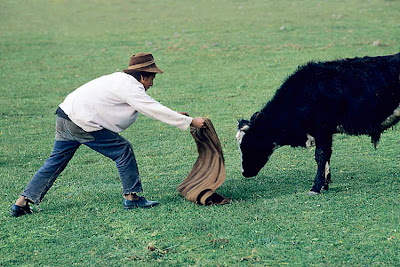Friday, February 25, 2011
Some of my Dogs, Past and Present
I wasn’t happy when one of my sons adopted it and, no longer allowed to keep it in a new apartment, he asked me to adopt it myself now. I had heard too many bad things about those dogs. But dogs are like kids. They behave according to their education and amount of love they get. Tango, my pit-bull, is the most loving, intelligent, comical, warm-hearted dog that I ever owned. He warms my heart and makes me laugh all day.
I’m posting a few of the three dogs’ pictures hereafter. To see them, please click on the previous post. To see more, please click on http://pa.photoshelter.com/c/victorenglebert, then on Galleries, and then on the dog photo.
Tuesday, December 29, 2009
Children of South America
Whether the kids are dirty or clean, you will wish that you could hug them. They will melt your heart. To view them, go to http://pa.photoshelter.com/c/victorenglebert, click on galleries, then on Collections, and finally on Children of South America.
Because the Peru and Colombia galleries have more than 50 pictures, the rest of them are hiding on a second page. Just click on the button at the bottom of the page to see it.
Anyway, hereafter are some sample pictures to titillate your interest.
Other website: http://Victorenglebert.com
Sunday, November 29, 2009
Having mentioned my children’s book, I must add that I have half a dozen others with an agent, all on kids of the developing world. The nationalities of American and European kids can be difficult to guess without some help because of the similarity of their cultures, housing, and dress. But children of Africa, Latin America, and Asia have widely differing cultures and ways of life, at least those who live isolated in deserts, forests, and mountains. And that can make them quite surprising.
I’ll post pictures of some of those other children’s books when I find the time. Meanwhile, you might enjoy viewing the three pictures that follow. They are among my most popular children’s pictures, at least among women, and I have large posters of them available.



Tuesday, November 24, 2009
Ecuador Cowgirls
Sunday, November 22, 2009
Hereafter, find a few pictures of Peru’s pre-Inca Chachapoya ruins. They are part of a recent story I did for Archaeology magazine. Those interested can see many more at a second website I’m working on.(http://pa.photoshelter.com/c/victorenglebert)
To those of you who already saw Machu Picchu and the Inca Sacred Valley I recommend that you travel next time to the Northern part of Peru, to the Amazonas Province, to see the great variety of Chachapoya ruins of ancient cities, fortresses, and mausoleums.
The region itself, including its people, much more often white and mestizo than farther south,
is very attractive too.
Saturday, September 12, 2009
An Amazing Odyssey
In my last blog I told you about Moise, the strong and fearless Cameroonian who punched a drunken chief of police in the face to punish him for ordering me to hand him my photographic equipment. He lives in Spain now, which he entered illegally. He’s been working there for a year. But he just lost his job to the recession.
Moise in December will fly to his native Douala and his wife and five kids. He earned a status that now allows him to fly back to Spain legally. He plans to do so in April, when he hopes to find a new job. Until December he will be paid unemployment. Though it won’t be much, it will be enough for him, living frugally, to add somewhat to his savings. Life is getting very difficult for Africans, and many will do anything to keep their families alive.
To reach Spain, Moise risked his life a couple times. First, Chadian rebels captured him and a few companions, and enslaved them. They taught them the use of firearms to later forcibly enlist them in their ranks. A month later, however, during the Ramadan, when every faithful Moslem must show acts of kindness, the rebels allowed them to resume their cross-Saharan journey.
On the Lybian coast, in the middle of the night to avoid Lybian coast guards, they joined 300 people in what he calls a pirogue, which says enough how unfit it must have been to hold so many people. Hardly out on the Mediterranean Sea, they were caught in a terrifying storm. Enormous waves constantly crashed on them, threatening to overturn and sink the boat. But thanks to every single person helping to bail out the boat, it finally made it past the Strait of Gibraltar and down to Las Palmas, one of the Canary Islands. Fortunately, every passenger was carrying a can for use as an individual urinal.
Five passengers lost their lives to fever along the way. As possible causes, Moise listed the cold, malaria, tuberculosis, and typhus. The ordeal lasted to the end. Italian islands were considerably closer to the Lybian coast, but too well guarded by coast guards. Besides, they are already saturated by unemployed Senegalese. The Canary Islands are apparently a stepping stone for illegal entry into Spain from Africa.
Moise was lucky. In Las Palmas he met a woman who got him a job contract in Spain. One look at him must have told her that this man was for real.
http://victorenglebert.com












































